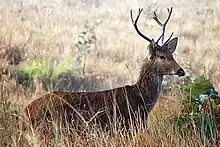Dudhwa National Park
national park in Uttar Pradesh, India
Dudhwa National Park, in Lakhimpur-Kheri District of Uttar Pradesh, adjacent to Nepal border, is one of the major projects for wildlife preservation in India.
Spread over an expanse of approximately 811 km² of marshes, grasslands and dense forests, it is a home for over 38 species of mammals, 16 species of reptiles and numerous species of birds. It has two core areas: Dudhwa National Park and Kishanpur wildlife sanctuary. They are 15 km apart with agricultural land between them. Unlike other major national parks in India like Corbett, Kaziranga, its noncommercial environment makes it an ideal place for animal and bird lovers to spend a day or two in peace, closest to nature.

The park has a sizable number of tigers and leopards, although the thick vegetation makes it difficult to spot one. The area once had a good number of Indian one horn rhinos which eventually fell to indiscriminate poaching. The rhino, brought in from Assam's Kaziranga in 1984, have once again thrived in the park. As a major environmental success, the park now boasts of over 30 rhinos, which are very likely to be spotted on a safari on the elephant back. The park also has swamp deer also known as 'barasingha' locally, elephants, Sambar, Cheetal and Hog deer, monkeys, langurs porcupines and a host of other animals. Nearly 800 varieties of birds are found in the park, including the Great Pied Hornbill, Flycatchers, Kingfishers, Drongos etc. Water bodies in the park attract a number of migratory birds from September till march and the rivers support a rich variety of turtles, crocodiles and fish. Gangetic dolphin is reportedly found in the Geruwa river. Dudhwa National Park is a home for 38 species of mammals, 16 species of reptiles, 400 species of birds and 90 species of fish. The main attraction of Dudhwa is swamp deer. Half of the world's 4000 swamp deer live here. Apart from this, four more types of deer found here: hog deer, spotted deer, barking deer and sambar. The officials figure on the population of tigers was 98 in 1995 but according to conservationist Billy Arjan Singh, who died in 2010, there is not enough prey to support more than 20 tigers. The rhino population has increased from 7 to 16 since 1984. There are a few leopards and a hispid hare has also been seen. Wild boars, elephants and bears also give an occasional sighting here.